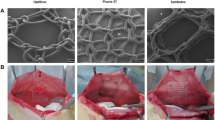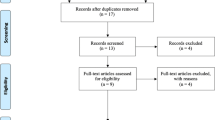Abstract
Purpose
Abdominal wall hernia is one of the commonest surgical disorders worldwide, and there is no single gold-standard operative technique to repair it. In an effort to improve techniques and technologies to reinforce hernia repair, synthetic meshes are employed. In this study, a new prosthesis (named composite) formed of two polypropylene layers, one macroporous (named mesh) and one transparent (named film), was examined to evaluate its capability to enable cell proliferation without inducing cell death. Inflammatory processes were also examined.
Methods
Human fibroblasts BJ were seeded on multiwells, on which composite or film had been placed. After 7, 14, and 21 days, cell growth and viability, deposition of collagen, and release of IL-6, IL-1β, and TNF-α were evaluated.
Results
The “in vitro” protocol showed the composite to be colonized by human fibroblasts on the polypropylene macroporous mesh side; no cell growth occurred on the film. The slowdown of cell growth observed between 14 and 21 days was accompanied by an increase in type I collagen deposition and marked fibroblast activity. Inflammatory cytokines initially increased, followed by their reduction beginning at 14 days.
Conclusions
The new prosthesis comprising two polypropylene layers of differing morphologies can be colonized by fibroblasts on the side facing the abdominal wall, whereas no cell growth occurs on the side facing the viscera. The transient inflammation, observed at early experimental times, is probably important for the healing process.








Similar content being viewed by others
References
Tam KW, Liang HH, Chai CY (2010) Outcomes of staple fixation of mesh versus nonfixation in laparoscopic total extraperitoneal inguinal repair: a meta-analysis of randomized controlled trials. World J Surg 34:3065–3074
The Ventral Hernia Working Group, Breuing K, Butler CE, Ferzoco S, Franz M, Hultman CS, Kilbridge JF, Rosen M, Silverman RP, Vargo D (2010) Incisional ventral hernias: review of the literature and recommendations regarding the grading and technique of repair. Surgery 148:544–558
Burger JW, Luijendijk RW, Hop WC, Halm JA, Verdaasdonk E, Jeekel J (2004) Long-term follow-up of a randomized controlled trial of suture versus mesh repair of incisional hernia. Ann Surg 240:578–583
Leber GE, Garb JL, Alexander AI, Reed WP (1998) Long-term complications associated with prosthetic repair of incisional hernias. Arch Surg 133:378–382
Sauerland S, Schmedt CG, Lein S, Leibl BJ, Bittner R (2005) Primary incisional hernia repair with or without polypropylene mesh: a report on 384 patients with 5-year follow-up. Langenbecks Arch Surg 390:408–412
Weyhe D, Belyaev O, Muller C, Meurer K, Bauer KH, Papapostolou G et al (2007) Improving outcomes in hernia repair by the use of light meshes—a comparison of different implant constructions based on a critical appraisal of the literature. World J Surg 31:234–244
den Hartog D, Dur AH, Tuinebreijer WE, Kreis RW (2008) Open surgical procedures for incisional hernias. Cochrane Database Syst Rev 3:CD006438
Amid PK (1997) Classification of biomaterials and their related complications in abdominal wall surgery. Hernia 1:15–21
Hollinsky C, Sandberg S, Koch T, Seidler S (2008) Biomechanical properties of lightweight versus heavyweight meshes for laparoscopic inguinal hernia repair and their impact on recurrence rates. Surg Endosc 22:2679–2685
Klosterhalfen B, Junge K, Klinge U (2005) The lightweight and large porous mesh concept for hernia repair. Expert Rev Med Devices 2:103–117
Novitsky YW, Harrell AG, Cristiano JA, Paton BL, Norton HJ, Peindl RD et al (2007) Comparative evaluation of adhesion formation, strength of ingrowth, and textile properties of prosthetic meshes after long-term intra-abdominal implantation in a rabbit. J Surg Res 140:6–11
Emans PJ, Schreinemacher MH, Gijbels MJ, Beets GL, Greve JW, Koole LH et al (2009) Polypropylene meshes to prevent abdominal herniation. Can stable coatings prevent adhesions in the long term? Ann Biomed Eng 37:410–418
Schug-Pass C, Sommerer F, Tannapfel A, Lippert H, Kockerling F (2009) The use of composite meshes in laparoscopic repair of abdominal wall hernias: are there differences in biocompatibility?: experimental results obtained in a laparoscopic porcine model. Surg Endosc 23:487–495
Burger JW, Halm JA, Wijsmuller AR, ten Raa S, Jeekel J (2006) Evaluation of new prosthetic meshes for ventral hernia repair. Surg Endosc 20:1320–1325
Zervolea I, Kletsas D, Stathakos D (2000) Autocrine regulation of proliferation and extracellular matrix homeostasis in human fibroblasts. Biochm Biophys Res Commun 276:785–790
Amid PK, Shulman AG, Lichtenstein IL, Sostrin S, Young J, Hakakha M (1994) Experimental evaluation of a new composite mesh with the selective property of incorporation to the abdominal wall without adhering to the intestines. J Biomed Mater Res 28:373–375
Muzio G, Maggiora M, Oraldi M, Trombetta A, Canuto RA (2007) PPARα and PP2A are involved in the proapoptotic effect of conjugated linoleic acid on human hepatoma cell line SK-HEP-1. Int J Cancer 121:2395–2401
Flum DR, Horvath K, Koepsell T (2003) Have outcomes of incisional hernia repair improved with time? A population-based analysis. Ann Surg 237:129–135
Kirkpatrick CJ, Otto M, Van Kooten T, Kriegsmann J, Krump V, Bittinger F (1999) Endothelial cell cultures as a tool in biomaterial research. J Mater Sci Mater Med 10:589–594
Weyhe D, Belyaev O, Buettner G, Mros K, Mueller C, Meurer K, Papapostolou G, Uhl W (2008) In vitro comparison of three different mesh constructions. ANZ J Surg 78:55–60
Velnar T, Bailey T, Smrkolj V (2009) The wound healing process: an overview of the cellular and molecular mechanisms. J Int Med Res 37:1528–1542
Schierano G, Canuto RA, Navone R, Peirone B, Martinasso G, Pagano M et al (2005) Biological factors involved in the osseointegration of oral titanium implants with different surfaces: a pilot study in minipigs. J Periodontol 76:1710–1720
Mozzati M, Martinasso G, Pol R, Polastri C, Cristiano A, Muzio G, Canuto RA (2010) The impact of PRGF on clinical and biological factors involved in healing processes following third molar extraction. J Biomed Mater Res A 95:741–746
Opal SM, De Palo VA (2000) Anti-inflammatory cytokines. Chest 117:1162–1172
Acknowledgments
This research was supported by grants from Regione Piemonte CIPE 2007—Converging Technologies, Italy, and from the University of Turin, Italy. We thank Mrs Frances Cooper for revising the English.
Conflict of interest
All the authors declare that there is no conflict of interest.
Author information
Authors and Affiliations
Corresponding author
Rights and permissions
About this article
Cite this article
Canuto, R.A., Saracino, S., Oraldi, M. et al. Colonization by human fibroblasts of polypropylene prosthesis in a composite form for hernia repair. Hernia 17, 241–248 (2013). https://doi.org/10.1007/s10029-012-0996-0
Received:
Accepted:
Published:
Issue Date:
DOI: https://doi.org/10.1007/s10029-012-0996-0




